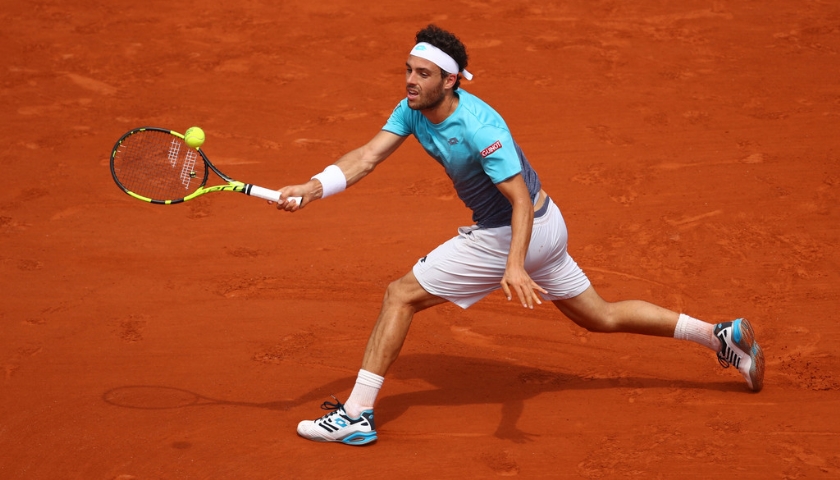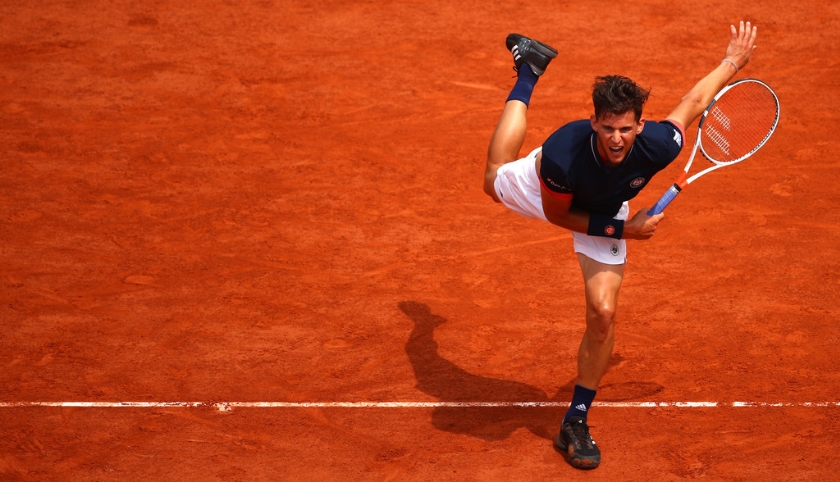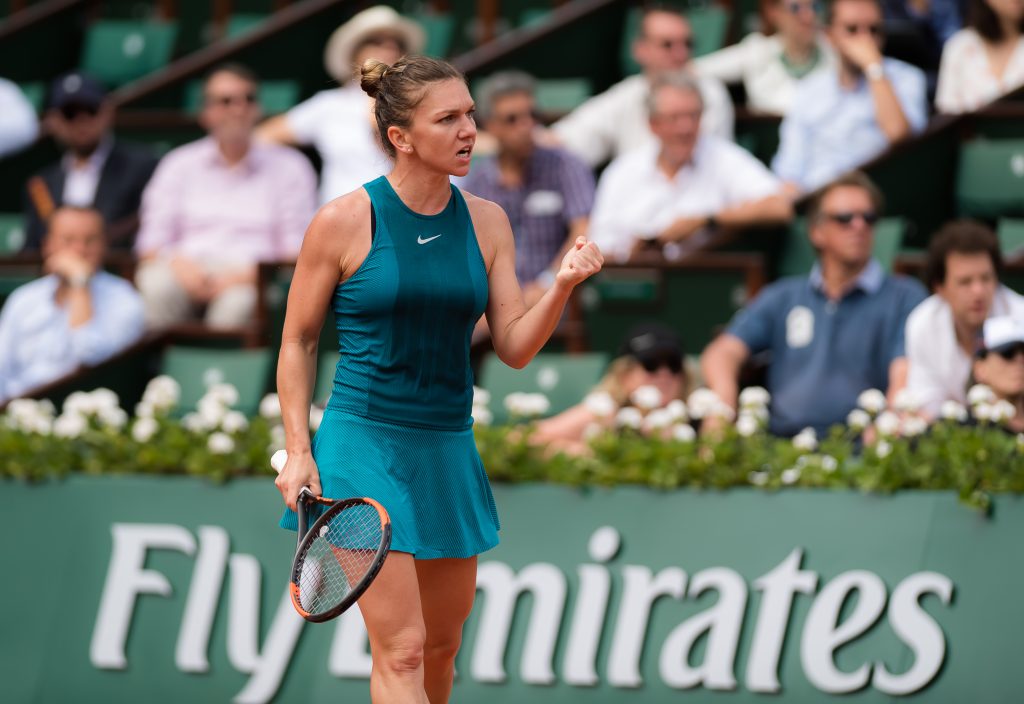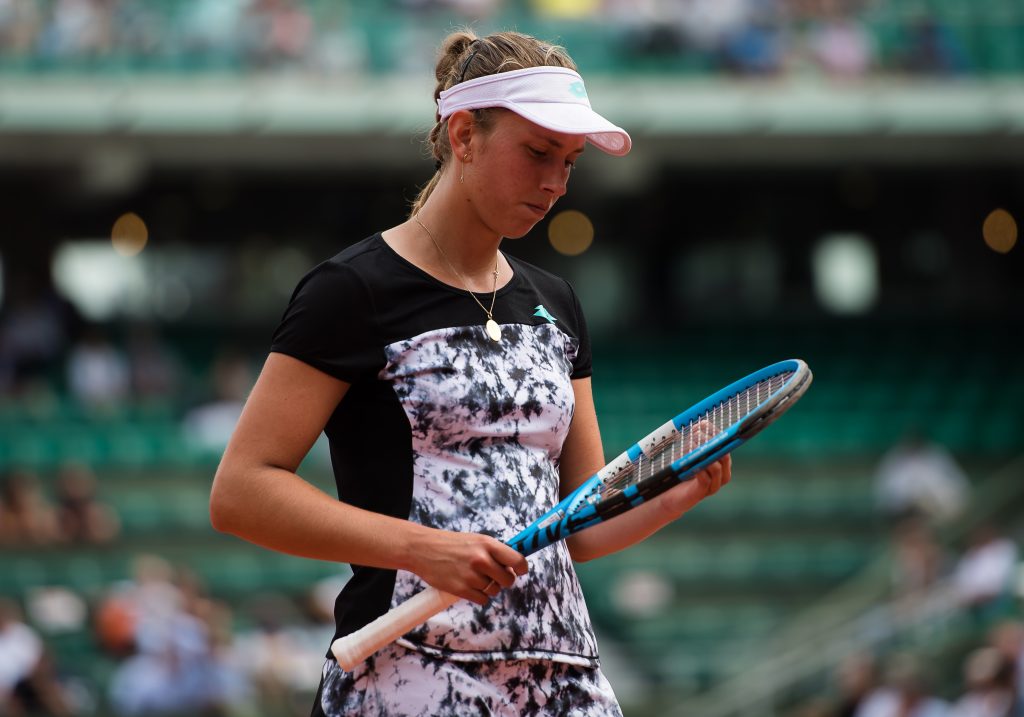This was as close a match-up to your typical David vs. Goliath encounter as you could see in the French Open, without involving the name Rafael Nadal. It pitted Dominic Thiem, an established top-ten player who has proven himself to be one of the top clay-court performers in the ATP ranks, against Marco Cecchinato, a virtual unknown to casual tennis fans whose rise to fame dates back to… three days ago!
That’s right, hardly anyone knew the 72nd-ranked player in the world before Tuesday’s quarterfinals, even though he had defeated Pablo Carreno Busta (no.11) and David Goffin (no.9) to get there.
It took his victory over Novak Djokovic in the quarterfinals – and the dramatic fourth-set tiebreaker that ended it – for most tennis fans and some so-called experts to familiarize themselves with the Italian.

He is your classic clay-court player, relying on his footwork and consistency from the baseline, while possessing a great touch. He neither has any big weapons from the ground nor possesses a powerhouse serve. He can drop-shot like you have never seen before, but that does not count as a weapon in the sense that you cannot base your entire plan on drop shots – more on that later. His tenacious baseline prowess was enough to carry him to his first career ATP title in Budapest earlier this year.
Thiem got out of this tricky semifinal match-up in straight sets, which is great news for him and his fans. I called it “tricky” only insofar as David vs. Goliath match-ups go, because in terms of what Thiem needed to do, it was not that complicated…
Until Thiem took it upon himself to complicate things, at least for a while…
In my match analysis of Thiem’s quarterfinal win over Alexander Zverev, I praised Thiem’s on-court IQ during the first set. I was ready to do again in this piece, because he began the match with a good game plan, setting the tone of the baseline rallies in a way that favored him.
This main theme of this plan consisted working the backhand of his opponent with high topspin shots, making the Italian muscle the ball back above his shoulder level over and over again. That would either him into committing errors or sending back short balls on which Dominic could pounce from inside the court. It also included the use of kick serves to the backhand on the advantage side to gain the advantage early in the rallies.
Assuming that Thiem successfully imposed this game on his opponent, Cecchinato would be limited to winning points via the use of “left-over” patterns such as the ones related to the use of drop shots, big first serves, or attacks to the net.
That would spell doom for Marco because he was not going to win the match using left-over patterns like the three above. Here are the reasons why:
Firstly, you cannot build your whole game plan on the use of drop shots, because they are specialty shots, so to speak. One should use drop shots sporadically at best, and only as a tool to render the larger game plan more efficient. In fact, drop shots lose their effectiveness when used too frequently. It’s an accessory shot. It’s a risky endeavor to hit drop shots against the best athletes in the world anyway, but even beyond that, and I will be blunt here, you will go nowhere if they represent the central component of your so-called winning plan.
Cecchinato was as efficient as he could get with his use of drop shots – he hits them extremely well on both wings – and won several points with it. There are many examples to cite, such as the deuce point at 1-3 in the first set and the third point of the second set. He even won his first three points in the second-set tiebreaker with drop shots. But he was still down 3-6 because Thiem won the other six points that were mostly based on baseline rallies.
It is true that Cecchinato came back to 6-6 and had chances to win the set, but what took place after 6-3 in that tiebreaker was not related to any adjustments by Marco, but rather to some major blunders by Dominic.
Secondly, Cecchinato does not have a big first serve. Some players manage to build successful game plans on them, but Cecchinato is not that guy, his first serve is not that serve. He won a few free points (ex: first point of the 5-5 game in the first set) but they were rare. Let me sum it up in one sentence. His first-serve percentage was at 80% and yet he only recorded two aces. Need I say more?
Thirdly, Cecchinato will win some points at the net, but the day that he builds an actual winning plan around his volleys, you can start expecting Richard Gasquet to beat Rafael Nadal at the French Open and turn around and beat Roger Federer at Wimbledon a month later. Just let me know when, I’ll be around.
In short, as long as Thiem could make Cecchinato hit a ton of backhands and limit him to left-over tactics, it seemed that he should be able to walk out of Philippe Chatrier without much difficulty and with plenty left in the gas tank.
It looked as if that were exactly going to be the case when the match began. He worked Marci’s backhand and broke his serve in the first game. For example, on the 30-15 point, he hit a high-topspin, inside-out forehand to Cecchinato’s backhand and forced the Italian to hit a backhand above his shoulder. It fell short, and Thiem executed the forehand winner to the open court.
In the next point, he sent two more high-bouncing balls to Cecchinato’s backhand and the Italian missed the second one wide. Later in the game, when Cecchinato managed to get a game-point opportunity at ad-in, Thiem returned sharp cross-court with his backhand and pushed Cecchinato outside the court to retrieve a backhand. Marco missed it in the net. When Dominic had the break point at ad-out, he hit another sharp cross-court return and Marco missed it deep this time.
It got even easier on Thiem’s service game, leading 1-0, because now he had the luxury to start the point by serving to Cecchinato’s backhand. For example, he won the second point thanks to a wide, kick serve that forced the Italian to try to muscle a backhand return from way outside the boundaries of the court. He missed it wide. He held serve to confirm the early break.
Thiem kept working Marco’s backhand and kept winning a ton of points (see the 40-30 point of the 4-2 game, for yet another illustration how Thiem successfully implemented this strategy). Let me be clear. Cecchinato’s backhand is not “bad” per se. But it can break down if a powerful striker like Thiem applies relentless pressure to it. Nadal, I imagine, would have a field day with it.
Cecchinato attempted to favor the ad side to avoid that pattern. That backfired when Thiem hit clean winners to the deuce court that he was leaving open (see the 15-0 point at 3-2 for one example). Meanwhile, Thiem’s wide serves worked so well on the ad side that even when Cecchinato returned well, he still had too much ground to cover to get to the next shot.
For example, on the 15-0 point at 2-1 in the second set, Thiem pushed Cecchinato wide with a kick serve again. Marco hit a tremendous deep return. Thiem had to quickly back up a couple of steps but managed to hit the ball back to the middle of the court. It was enough to win the point, because Marco simply did not have enough time to recover back to the middle of the court.
It just seemed to make sense that Thiem would stick with this plan and cruise to a pain-free three-set victory. It turned out to be a straight-set one indeed, but definitely not free of pain.
Thiem, serving at 4-3, sent a slice backhand in the net and double-faulted to all of a sudden find himself down 0-40. He immediately went to his bread-and-butter and served three times in a row to Cecchinato’s backhand. The Italian missed the first two returns. He returned the third one in, but Thiem simply accelerated to the open deuce court to win the point. His plan was working, he simply needed to stick to the script.
What was not included in this script was missing easy put-away volleys in the net. It happens every now and then to every player, but it did not need to happen to Thiem at 4-3, deuce. And he certainly did not need to follow that up with an unforced error on a routine cross-court backhand to lose his break advantage.
At 5-5, we saw the best game of the match, featuring high-quality shot production from both players and extended rallies. Thiem ultimately broke Cecchinato’s serve, because Cecchinato, as noted above, depended on left-over tactics. He needed to either hit a big first serve or produce a winner during the rally. The game ended after Thiem forced him to hit another defensive backhand that landed short and nailed it away with his forehand.
The Austrian held serve and pocketed the first set.
Logic dictates that Thiem would go back to his working – and simple – game plan, but for some reason, he did not. He would at times go for huge, flat winners from far behind the baseline. At others, he would hit the ball to Cecchinato’s forehand when he could have easily accelerated it to the Italian’s backhand. He also did not use his wide serve nearly as much as he did against Zverev, even though it was such an obvious part of a winning plan here.
So, it was a neck-to-neck affair in the second set. It went into a tiebreaker, and it took Thiem five set points to finally win it 12-10 (on a point that started with another kick serve to the outside by him), but it should have never gone that far for Thiem. It could have also taken a very dark turn for him had Cecchinato capitalized on one of the three set-point opportunities he had himself.
First one came at 7-6, and Dominic saved it with a wide serve (Marco missed the return in the net). Second one came at 9-8 and Dominic saved that one too with a wide serve (Marco framed the backhand out). Again, the winning formula for Thiem was so clear from one end of the match to the other that I kept wondering why he tried anything else at all. He took a page out Cecchinato’s book when he saved the third set point with a beautiful drop shot.
Cecchinato’s mental resolve took a hit once he went down by two sets: “I go a little bit down with mental, and physically I play so many matches, so I think is normal,” he said after the match. Thiem echoed those sentiments: “The second-set tiebreak was the big key to the match, 100%, because obviously he felt all the matches from these two weeks after that.”

The match ended 28 minutes after that tiebreaker with the final score of 7-5 7-6 6-1 in Thiem’s favor. It was an up-and-down performance by Thiem, one that probably made some of his fans feel uneasy. His decision-making was questionable at times, not because he had a bad game plan, but because he did not stick to it. When your plan works, why stop doing it? To be clear, Thiem did not completely stop using it, but used it only in short bursts.
There is some good news for Thiem and his fans. He has not had to play any five-set matches so far, winning his last two in straight sets. He also showed high-IQ in terms of devising a working game plan against both of his last two opponents. Against Zverev he remained loyal to it all through the first set (he did not need to in the second and third ones). Against Cecchinato however, he did not, and he paid for it by playing a much closer match than he should have.
For Thiem, on-court decision-making will matter the most. The question is, can he execute his plan properly? We know that he already has one for Nadal because he literally said so in his post-match press conference: “he’s a big favorite against everybody. Still, I know how to play against him. I have a plan.”
“If I want to beat him, I have to play that way like I did in Rome and in Madrid.
But I’m also aware that here it’s tougher. He likes the conditions more here than in Madrid, for sure. Best of five is also different story. I think also a good thing is that I faced him already twice here.”
As to whether Rafa will allow that plan – or any other one – to succeed or not, that is a completely different question. That is the challenge that Thiem must overcome if he aims to go where no other tennis player has gone before, which is, to defeat Rafael Nadal in the final round of the Internationaux de France on Court Philippe Chatrier.


